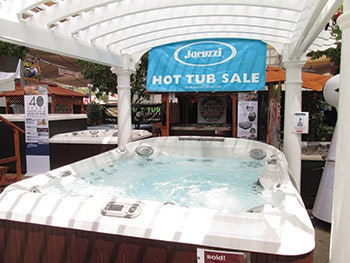
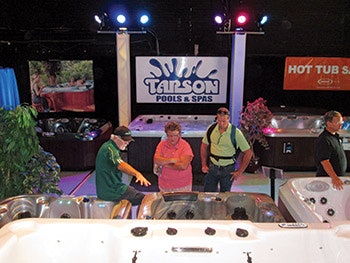
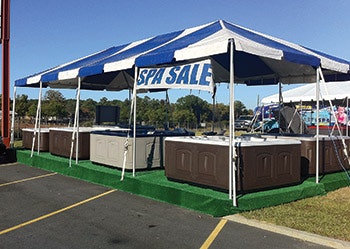
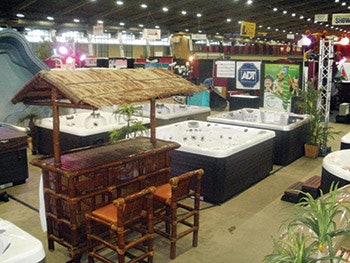
Traveling salesman is a profession with a slightly shady reputation, but Sean Hunsinger and Michael Coleman are out to change that. The duo are co-founders of Spa Show Pro, a company that sends skilled sales staff — or “event specialists,” as Hunsingzer and Coleman say — to spa dealers and manufacturers nationwide to lend their expertise and keep the cash register ringing. And the key to their success? A moral, fair approach.
“Michael and I met and started talking about an ethical vehicle for getting work for quality salespeople and overcoming the stigma that our business is nothing more than a sideshow,” Hunsinger says. “We believe that if you put the same business practices to selling spas as you do to selling multi-million dollar homes, you’ll be successful.”
Spa Show Pro launched in 2011 and is now a strong success with a network of about 40 sales professionals and a calendar booked with events for months to come. Looking to put on an event at your dealership? Here’s some advice from the experts themselves.
1. Consider what kind of event you want to hold.
Generally, there are three different kinds of hot tub events: the home show (at which you exhibit alongside other companies), the tent sale and the super sale. Tent sales and super sales are similar in concept — both are big events that take place at your location — but differ in scale.
“The tent sale is the most economical of the three, whereas with a super sale, you can spend in excess of $60,000 to $70,000 to put on a successful sale,” Hunsinger says.
But what you put into it is a sign of what you might get out of it.
“Your risk with a tent sale is far less, but you’re not going to do a million dollars,” Hunsinger says. “My best super sale was $2 million in four days.”
2. Create a plan…
“My recommendation is to create a roadmap of what your goal is and go backwards,” Hunsinger says. “Lets say I want to sell 30 units. If I sell 30 units, how many salespeople do I need to do that? If your average sales guy sells six hot tubs, and you want to sell 30 units, then you need to bring in five hot tub guys.”
3. …and do it way in advance.
If you do find you need to hire more people to assist in your show, it’s best to plan ahead.
“In many cases, I would say a year is the best way to go,” Coleman says.
“If you are going to use show guys, you have to book them early, otherwise you’re going to end up with a tier two salesman,” Hunsinger adds.
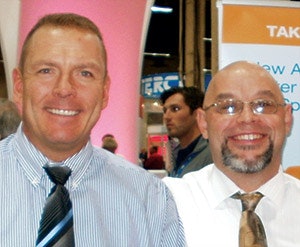
4. Remember: Looks matter.
“If you just put product out there that has no presentation, consumers aren’t going to be attracted to it,” Coleman says. “We find dealers are more successful when they put some effort into their booths and dress them up with decorations: place settings, little bar kits, trees in the booths, plants, banners that show relaxation and what the products really offer people.”
To put it another way: hot tub dealers have complete grasp of their product and how it appears in a backyard environment. Customers, on the other hand, need some help.
“There are a lot of folks who don’t have vision; they have a hard time seeing what you describe, so if you just build what you’re describing, they come in and say ‘I want that,’” Coleman says.
5. Critically consider your sales force.
Not all spa sales staff are created equal.
“Event people are far different than showroom salesmen. This is key,” Hunsinger says.
According to Hunsinger, a customer will visit a showroom about three times before making a purchase, giving the sales rep plenty of time to show off the features, answer questions and even offer a test soak. That’s not the case at an event.
“The sales cycle is much shorter and the sense of urgency is much greater at an event,” he says.
Can your sales team adapt to the fast-paced atmosphere of a tent event or home show?
“There are some salespeople that can do both, but they are very few and far between,” Hunsinger says.

6. Don’t neglect your showroom.
“Sometimes, when you take your best salesmen out of your showroom and you send them down to a home show or an event, you lose sales in your showroom because there are people who prefer to purchase that way,” Coleman says.
As a matter of fact, you may want to keep an eye out for when your competitors have spa sales, Coleman says. When one dealership holds a sales event, traffic at a competing showroom often spikes.
The 6-Step Sales Process
Below, Sean Hunsinger shares how the sales process works in the event environment. Remember, the interaction described below takes place in roughly 30 minutes or less.
1. Introduction “You need to find common ground. You can do it with humor, with lightness, with a variety of things, but you have 30 seconds or less to get that customer to open up to you.”
2. Prospecting “You have to find out if they’re capable of buying and if they’re willing to buy. This stage is huge, because a lot of people are capable of buying, but aren’t going to buy today. A lot of people are willing to buy, but they don’t have the means to. So in an environment where you have to maximize your potential, you have to find those people that are capable and willing to buy.”
3. Discovery “Ask them some pointed questions to find out what their needs are, and using your expertise, find the product that best fits their needs,” Hunsinger says. If, for example, your prospect wants to entertain, show her a hot tub with plenty of seating. If she wants to soothe arthritic pain, show her a model with hydrotherapy features.
4. Presentation “The presentation stage involves finding out what the customer’s hot points are, addressing those hot points, and relaying them back to the customer,” Hunsinger says. Go back to the discovery phase, consider what your prospect told you he/she is looking for, and show how this particular model fulfills those needs.
5. Q&A Naturally, customers are going to have some questions before making a big buy. Take some time to answer them.
6. Close Try one of the following approaches to get a final answer from your guest:
Tie-down approach: Ask a series of questions to convince the prospect to commit. (Hunsinger likes these three: “You said you were looking for X, correct? This product fulfills your needs, correct? What’s our next step?”)
“A series of little yeses will get the big ‘yes’ at the end,” he says.
Simple approach: “Sir, what do you think? Can I put a hot tub in your backyard?”
Either/or approach: “Would you like this in the blue color or would you like this in the red color?”
Comments or thoughts on this article? Please e-mail [email protected].












































